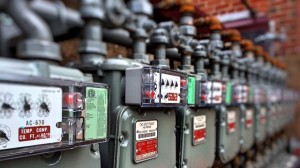 The Electricity Monitoring Project
The Electricity Monitoring Project
The Start ….
The objective of this project is to further reduce our electricity use.
Even though we purchase all ‘green’ electricity, which means that our electricity consumption is from renewable sources, and we are not adding to emission in the atmosphere, I am still trying to reduce the amount we use. The other day THS quite reasonably asked me why I was trying to reduce our electricity consumption now we buy all green. I had to stop for a moment and ask myself if it was anything other than habit, but I believe it is more than habit. I want to reduce our electricity consumption for the following reasons:
- to see how low we can get it and still live a comfortable lifestyle
- I would love to go off grid one day and the less electricity your home uses, the less the infrastructure costs of going off grid living
- our electricity supply may become intermittent one day (no-one really knows how countries are going to manage the transition to widespread renewable energy)
- electricity retailers may pay us to not use electricity at certain time of peak demand which could be similar to intermittency but a matter of choice rather than national circumstance
- I just want to understand
Anyway, there are many websites around, as well as research, that says if we monitor our electricity use, we usually reduce our consumption by about 10%. Sounds good! To date I have been monitoring our consumption via our retailers sites plus looking at the backs of appliances to find our how much electricity they use, but that is all a bit tedious and yet another example of nerdy behaviour so I thought I would find out if I could get a gadget. I am looking for a gadget that:
- is not too expensive (under $200 would be good; I know it is possible to get systems in the thousands of $ range but that is unaffordable and it would take for ever to achieve a ‘payback’ in terms of electricity savings)
- would monitor usage in the moment (many monitor the aggregate for the day)
- could be put on a bench or on a wall so everyone in the house can look at it
- would tell us when the solar system was generating electricity and how much (our system is now five years old and not easy to monitor; newer ones have much better feedback software)
And Then ….
Ab out a year ago I started this project (things happen slowly around here) and I found a small monitor called an eKo TotEM that was endorsed by one of the State government departments and only cost about $70 with a further reduction of $20 if you applied for a government refund. Perfect! It duly arrived via mail and I set it up. In part, it read data from our Smart Meter which is about 40 meters away from the house (we live on a rural property). It was complicated to set up properly but it had a simple green, amber and red dot system that told you if you were using a lot of electricity (or not) and this part of it did not require any set up, only to be plugged in. When it was finally set up properly and actually worked, it was pretty interesting to everyone in the house, but quite a lot of the time, it didn’t work properly. The technician at the supply company was really patient and helpful but it turns out that our Smart Meter is too far from the house for it to ever work properly. I sent it back and the supplier readily agreed to a refund. I recently returned to the site to see if anything has changed and there is a banner in front of the website saying that the product has been discontinued and the website is there for ‘reference only’. Shame – they were on the right track.
out a year ago I started this project (things happen slowly around here) and I found a small monitor called an eKo TotEM that was endorsed by one of the State government departments and only cost about $70 with a further reduction of $20 if you applied for a government refund. Perfect! It duly arrived via mail and I set it up. In part, it read data from our Smart Meter which is about 40 meters away from the house (we live on a rural property). It was complicated to set up properly but it had a simple green, amber and red dot system that told you if you were using a lot of electricity (or not) and this part of it did not require any set up, only to be plugged in. When it was finally set up properly and actually worked, it was pretty interesting to everyone in the house, but quite a lot of the time, it didn’t work properly. The technician at the supply company was really patient and helpful but it turns out that our Smart Meter is too far from the house for it to ever work properly. I sent it back and the supplier readily agreed to a refund. I recently returned to the site to see if anything has changed and there is a banner in front of the website saying that the product has been discontinued and the website is there for ‘reference only’. Shame – they were on the right track.
I used Google to search for suppliers of monitors that are able to tell me how much solar power we generated, as well as exported, and how much electricity we used from both our solar array and the grid. Ideally, the monitor will be able to tell me how much electricity certain key appliances use.
I found and contacted two suppliers of monitors – Power Tracker and e*star, asking them via their websites if their product would be suitable for what I wanted and how much they would cost.
The following working day I heard back from Power Tracker. It looks like their product is suitable and almost affordable at just under $400 without installation. For this price you have the ability to monitor one appliance or possibly one circuit. This is something I’m not clear about. Screen shots they sent of the web-based monitoring tool look like more than I need but what I do need is there.
On the same day two minutes later, I received another email from Power Tracker saying that an account had been created for me and I needed to activate it and select a password. I didn’t do anything because I had no idea what this email was about; it seemed a long way off a product and price inquiry and I didn’t have time to look at it in more detail. The next email I received from Power Tracker was a further three minutes later saying the my ‘ticket’ had been resolved and would be automatically closed in 48 hours. Who knows what this might mean but exactly 48 hours later another email arrived saying my ‘Ticket – Monitor for Electricity Generation and Consumption’ has been closed and would I rate my experience based on one of three hyperlinked images of happy faces. I ignored these emails.
And Then ….
I have delayed any further action on this project until today, when all I can conclude is that they sent three out of four of emails to me in error.
I have one more thing to do and that is to follow a hyperlink in their product and price response email and see where it takes me. Oh well – just had a try and it takes me to a login page for ‘tickets’ which are a mystery at this stage.
It is now nearly ten weeks since I sent my two inquiry emails and I still haven’t heard back from e*star so I guess they are not for me.
And Then ….
Over the Christmas period we visited relatives who have a solar system on their roof. Their inverter is in their garage and I saw that it automatically displays how much solar power they generate and have generated in total. I think it also tells them how much of their own power they have used. This is not quite what I want in terms of home monitoring but I wonder if, somehow, our inverter might be capable of something similar. It certainly doesn’t display this kind of information by default but maybe if I press a few buttons I will learn something useful. Our inverter model is at least five years old, probably more, so that is getting pretty old, given how rapidly the technology is improving.
Ahhhhh – I went outside to see what our inverter is capable of and it is not working! Follow this story via The Faulty Inverter Incident!
The Latest ….
As part of my efforts to deal with The Faulty Inverter Incident, I found that our inverter does have some capabilities that I wasn’t aware of.
Following installation of a replacement inverter, I took the opportunity to scroll through the various screens on the inverter’s display panel. Most of them I either didn’t understand or they were of no interest, but two were of interest. One tells me how many kWh the inverter has generated for as long as it has been operating, and the other tells me how many watts the array is generating in the moment. Both are interesting. The former because it allows me to calculate how much of our own electricity we actually use, by subtracting the amount sold to the grid from the total generated. The second reading is useful because it tells me how many watts are being generated in the moment. Yesterday, for much of the day it was generating around 300 watts which meant I could confidently turn on the washing machine. To date, I have been looking at the amount of sunshine and cloud cover to made the same judgement. I will probably use both ways to work out if I want to turn appliances on or not.
One problem with calculating electricity use as I described in the preceding paragraph, is that the inverter can be reset to zero, but I’m not sure under what circumstances. Certainly if it is replaced, the count starts again at zero. Another problem with this method is it is cumbersome; you have to collect information from both the inverter and your Smart Meter or invoice, assure yourself that the date and time ranges are the same, then perform a manual calculation. Not something that most people would be interested in doing and not something that even I am prepared to do regularly so I still think and in-house monitor would be really good so long as it is affordable.
This morning I was reminded why electricity monitoring that is comprehensive, simple, in real-time and ‘in your face’ is widely regarded as an effective way of reducing electricity use.
I often log on to our electricity retailer site to see our pattern of usage. Usually there is nothing new but sometime there is and it has always been something negative. So far, on both occasions, when there definitely was something new to see, I had been distracted with other things and hadn’t logged on and so hadn’t noticed something was wrong.  As well as the changes that arose because of our faulty inverter, when I logged on this morning, I saw that our overnight use of power had almost tripled. Of course I immediately called out to THS to ask if he could think of why this had happened; I certainly couldn’t. THS had no insights so I thought I would ignore the issue for a while and see if any ideas spontaneously arose and, bingo, I suddenly knew why a tripling of our electricity use had happened. Thirty six hours ago we had no electricity for 12 hours, following a massive storm (good news is that we got 14 mm of rain out of the storm). I have two timers set; one on the heat pump so it operates during times of sunlight and one on the water recirculator so it operates at those times when we are likely to need hot water. Neither has an internal re-chargeable battery so, when the power goes off, they end up being ‘out’ by the duration of the power failure. Usually I remember to reset them but this time I didn’t, so the heat pump was working hard to drag heat out of the night air and the water recirculator was pushing water around at times when we definitely didn’t need it to be doing so. If we had a bench top or wall mounted monitor, that showed what our usage was at any given moment, then we would get used to regularly seeing a pattern and be able to react quickly when that pattern wasn’t as expected. So, I will keep going in my hunt for an affordable, effective monitor.
As well as the changes that arose because of our faulty inverter, when I logged on this morning, I saw that our overnight use of power had almost tripled. Of course I immediately called out to THS to ask if he could think of why this had happened; I certainly couldn’t. THS had no insights so I thought I would ignore the issue for a while and see if any ideas spontaneously arose and, bingo, I suddenly knew why a tripling of our electricity use had happened. Thirty six hours ago we had no electricity for 12 hours, following a massive storm (good news is that we got 14 mm of rain out of the storm). I have two timers set; one on the heat pump so it operates during times of sunlight and one on the water recirculator so it operates at those times when we are likely to need hot water. Neither has an internal re-chargeable battery so, when the power goes off, they end up being ‘out’ by the duration of the power failure. Usually I remember to reset them but this time I didn’t, so the heat pump was working hard to drag heat out of the night air and the water recirculator was pushing water around at times when we definitely didn’t need it to be doing so. If we had a bench top or wall mounted monitor, that showed what our usage was at any given moment, then we would get used to regularly seeing a pattern and be able to react quickly when that pattern wasn’t as expected. So, I will keep going in my hunt for an affordable, effective monitor.
To Be Continued ….
